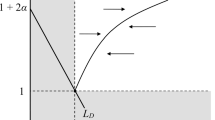Abstract
In order to analyze a multi-player linear-quadratic alternating-move dynamicgame, this paper develops a solution method by making use of the similarstructure of this game and a simultaneous-move dynamic game with alternatingpayoff functions. It then applies the method to investigate whether staggeredor synchronized wage adjustment will be preferred when more than two wagesetters interact strategically and dynamically. The results suggest that thestrategic benefit provided by staggered wage adjustment is robust with respectto the number of sectors in the economy.
Similar content being viewed by others
References
Ball, L. and Romer, D. (1989). The equilibrium and optimal timing of price changes. Review of Economic Studies, 56, 179–198.
Basar, T. and Olsder, G.J. (1999). Dynamic Noncooperative Game Theory, 2nd edn. SIAM, Philadelphia.
Cahuc, P. and Kempf, H. (1997). Employment and wage bargaining in an open monetary union. Review of International Economics, 5(supplement), S92–S110.
Cyert, R.M. and De Groot, M.H. (1970). Multiperiod decision models with alternating choice as the solution to the duopoly problem. Quarterly Journal of Economics, 84, 410–429.
De Fraja, G. (1993). Staggered vs. synchronised wage setting in oligopoly. European Economic Review, 37, 1507–1522.
Fethke, G. and Policano, A. (1984). Wage contingencies, the pattern of negotiation and aggregate implications of alternative contract structures. Journal of Monetary Economics, 14, 151–170.
Fethke, G. and Policano, A. (1986). Will wage setters ever stagger decisions? Quarterly Journal of Economics, 101, 867–877.
Fischer, S. (1977). Long term contracts, rational expectations, and the optimal money supply rule. Journal of Political Economy, 85, 163–190.
Kydland, F. (1975). Noncooperative and dominant player solutions in discrete dynamic games. International Economic Review, 16, 321–335.
Lau, S.-H.P. (1996). Aggregate pattern of time-dependent adjustment rules, I: A game-theoretic analysis of staggered versus synchronised wage setting. Economic Journal, 106, 1645–1658.
Layard, R., Nickel, S. and Jackman, R. (1991). Unemployment – Macroeconomic Performance and the Labour Market. Oxford University Press.
Maskin, E. and Tirole, J. (1987). A theory of dynamic oligopoly, III: Cournot competition. European Economic Review, 31, 947–968.
Tanaka, Y. (1994). Export subsidies under dynamic duopoly. European Economic Review, 38, 1139–1151.
Taylor, J.B. (1980). Aggregate dynamics and staggered contracts. Journal of Political Economy, 88, 1–23.
Author information
Authors and Affiliations
Rights and permissions
About this article
Cite this article
Lau, SH.P. Solution of Multi-Player Linear-Quadratic Alternating-Move Games and Its Application to the Timing Pattern of Wage Adjustment. Computational Economics 19, 341–357 (2002). https://doi.org/10.1023/A:1015568516528
Issue Date:
DOI: https://doi.org/10.1023/A:1015568516528




